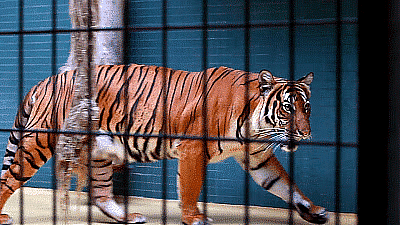About the Poet
George Leslie Norris (21 May 1921 – 6 April 2006), was a prize-winning Welsh poet and short story writer. He taught at academic institutions in Britain and the United States, including Brigham Young University. Norris is considered one of the most important Welsh writers of the post-war period, and his literary publications have won many prizes.

Key Points of the Poem
- The poem consists of 5 stanzas. All stanzas are made up of 4 lines. Thus, the entire poem consists of 20 lines in total.
- This poem contrasts a tiger when it is in its natural habitat and when it is imprisoned in a zoo.
- On a starry night, the poet sees a tiger in a zoo.
- The tiger moves slowly up and down in his cage.
- The tiger is full of rage but is quiet in his helplessness.
- The poet is moved to pity for the tiger.
Detailed Summary
Stanza 1
He stalks in his vivid stripes
The few steps of his cage,
On pads of velvet quiet,
In his quiet rage.
Here the poet says that the tiger that is confined in the zoo moves around in the cage under his bright coloured skin. He further says that the tiger can take only a few steps because the cage is small and it is not easy to move in it. One cannot hear his footsteps because he has very soft feet, like velvet because of which there is no sound of the tiger’s footsteps. The tiger tries to control his anger by quietly walking in the limited area of his cage. He is angry because he is not free.
Stanza 2
He should be lurking in shadow,
Sliding through long grass
Near the water hole
Where plump deer pass.
The poet says that if this tiger was free, he would have hid himself behind the long grass near the water bodies so that he could easily catch a deer in order to have it as its food. Basically, the poet wants to say that the actual life of a tiger is to live in jungle where he could catch his prey and eat it but the tiger in the cage can not do so .

Stanza 3
He should be snarling around houses
At the jungle’s edge,
Baring his white fangs, his claws,
Terrorising the village!
The poet says that if the tiger would have been free, he would have snarled around the houses located at the outskirts of the forest. He would terrorise people with his sharp tooth and claws. This would create fear among the people living in the villages.
Stanza 4
But he’s locked in a concrete cell,
His strength behind bars,
Stalking the length of his cage,
Ignoring visitors.
Now the poet comes to the reality of the tiger that is inside the cage. He says that the tiger is confined in a strong cell which is made of strong building material. He further says that as the tiger is behind bars, so his ferociousness is also behind the bars. He just stalks in the cage. He never tries to terrorise the visitors because his power is restricted by the cage. Therefore, he never tries to terrorise the visitors as he cannot attack them.
Stanza 5
He hears the last voice at night,
The patrolling cars,
And stares with his brilliant eyes
At the brilliant stars.
The poet says that in the night, the tiger hears the sounds of the patrolling cars. Patrolling cars are the vehicles of police which are used to guard at night. So, in the night the tiger hears the sounds of these cars. He then stares at the shining stars with his shining eyes. The poet wants to say that the tiger is sad and as he is confined in the cage, so, he cannot do anything. Therefore, he stares at the stars in the night and tries to divert his thoughts towards them.
Theme/ Message
Theme
- The theme is ‘freedom vs. captivity’. Freedom is desired by humans and animals alike. The poem shifts between the condition of the tiger in confinement and the life he would have lived in the wild if he were free.
- The poem brings forth the extreme agony and hopelessness of the caged tiger and his desire for freedom
Message
- The poem gives us the message of ‘liberty for animals’. It tells us that it is wrong to confine animals in zoos for the sake of entertainment. Every animal, like humans, desires to live a life of freedom.
- Animals too have a right to live freely on this earth and it is a cruel practice to cage them and force them to live a life full of agony inside their small cells.
Literary Devices
Imagery - The imagery is conveyed through
‘vivid stripes’, ‘lurking in the shadow’, sliding through long grass’, ‘snarling around houses’, terrorising the village’, ‘stalking the length of his cage’, ignoring visitors’, ‘stars with his brilliant eyes’, ‘at the brilliant stars’Symbolism - Norris symbolises the words ‘cage’ and ‘sky’.
‘Cage’ symbolises the captivity of the tiger by humans.
‘Sky’, on the other hand, symbolises the freedom that the caged tiger longs for.
By symbolising ‘cage’ and ‘sky’, Norris shows the helplessness of the tiger.Oxymoron – The use of two consecutive words that have contradictory meanings.
The poet uses the phrase ‘quiet rage’, in which the words ‘quiet’ and ‘rage’ have contrasting meaning making it mean ‘silent anger’ or ‘suppressed anger’.
This contrasting phrase is used to convey that though the tiger is quiet in the cage, it is full of rage.Personification - The tiger is referred to with the use of the pronoun ‘he’, implying that he can feel like humans do, that is, feeling helpless at being imprisoned and wanting to be free.
Therefore, the tiger has been personified, that is, has been given human-like qualities in this poem.Alliteration – Repetition of initial consonant sounds in the same line Alliteration has been used in phrases
‘should be lurking in shadow’
‘plump deer pass’, ‘in a concrete cell’
By highlighting soft sounds like ‘s’, ‘p’ and ‘c’, Norris draws the readers’ attention towards the tiger’s condition – what it is and what it should be.Metaphor – Metaphor is a literary device used to make a comparison without using the words ‘like’ or ‘as’.
‘On pads of velvet quiet’ – this phrase compares the paws of the tiger to velvet because of the quality of softness of velvetRepetition – Repetition of words/phrases in the same line.
The words ‘stalk’, ‘quiet’ and ‘brilliant’ are repeated throughout the poem.
The word ‘stalk’ and ‘quiet’ refer to the strength of the tiger and how it has been trapped inside the cage.
The word ‘brilliant’, on the other hand, refers to both the sky and the tiger’s eyes. It represents the tiger’s yearning to be free.Enjambment – Sentence is continuing to next line without any punctuation mark
Stanza 2 – the second and the third lineMetonymy – This poetic device consists of the substitution of the name of an attribute or adjunct for that of the thing meant.
In this poem, the poet uses the device of metonymy in the 2nd line of the 4th stanza. He uses the word ‘strength’ to mean the body of the tiger, where the entire strength of this majestic creature resides and which is locked up within a cage in the zoo.Consonance – Use of ‘s’ sound (stalks, his, stripes)
Assonance – Use of vowel sound ‘I’ (in his vivid stripes).



